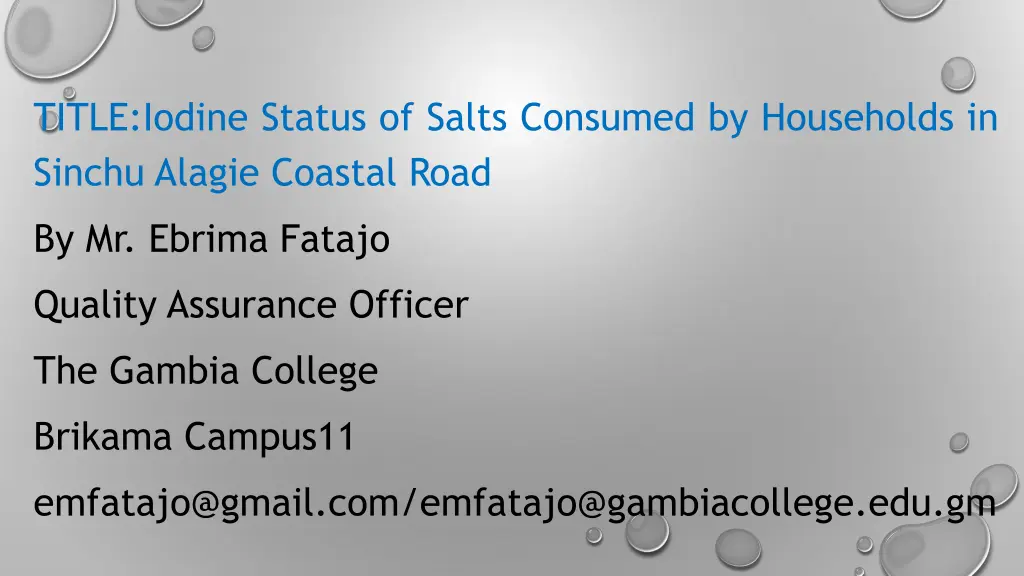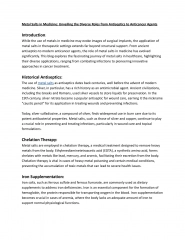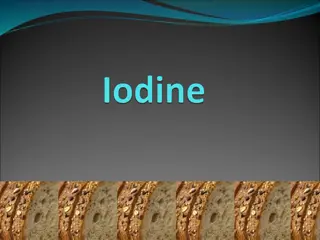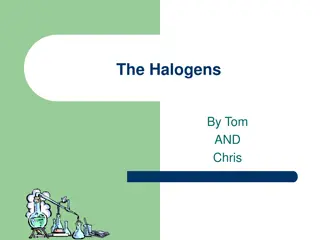
Iodine Status in Sinchu Alagie Coastal Road
"Investigation of iodine status in salt consumed by households in Sinchu Alagie Coastal Road reveals inadequate iodine levels, posing risks of iodine deficiency disorders. Further research is recommended to verify findings and ensure sufficient iodine content for community health."
Download Presentation

Please find below an Image/Link to download the presentation.
The content on the website is provided AS IS for your information and personal use only. It may not be sold, licensed, or shared on other websites without obtaining consent from the author. If you encounter any issues during the download, it is possible that the publisher has removed the file from their server.
You are allowed to download the files provided on this website for personal or commercial use, subject to the condition that they are used lawfully. All files are the property of their respective owners.
The content on the website is provided AS IS for your information and personal use only. It may not be sold, licensed, or shared on other websites without obtaining consent from the author.
E N D
Presentation Transcript
TITLE:Iodine Status of Salts Consumed by Households in Sinchu Alagie Coastal Road By Mr. Ebrima Fatajo Quality Assurance Officer The Gambia College Brikama Campus11 emfatajo@gmail.com/emfatajo@gambiacollege.edu.gm
Iodine Status of Salts Consumed by Households in Sinchu Alagie Coastal Road PRESENTATION OUTLINE Abstract Introduction Objectives Methodology Results Discussion Conclusion Recommendations References
Iodine Status of Salts Consumed by Households in Sinchu Alagie Coastal Road ABSTRACT Iodine deficiency disorders (IDD) are highly prevalent in The Gambia with dire consequences for the population especially women and children (national nutrition policy (2010-2020). Universal salt iodisation, a strategy to improve access to iodine was adopted by WHO/UNICEF. This strategy was implemented by The Gambia to enhance the nutritional status of its citizens. It is towards this background that; this research seeks to determine the adequacy of iodine is the salts used in the study area. 200 households were visited and salt samples were collected for analyses.
Iodine Status of Salts Consumed by Households in Sinchu Alagie Coastal Road The results indicated that 3.5 %( n=7) of the households has adequate amounts of iodine. Consequently, the research revealed that the iodine content of salt in the study area fell short concentration. Further research with a wider scope is required to validate this finding. of the universally acceptable
Iodine Status of Salts Consumed by Households in Sinchu Alagie Coastal Road INTRODUCTION Iodine is an essential component of the hormones produced by the thyroid gland and therefore essential for mammalian life. Iodine deficiency is a major public health problem; globally, it is estimated that two billion individuals have an insufficient iodine intake. Although goitre is the most visible sequelae of iodine deficiency, the major impact of hypothyroidism due to iodine deficiency is impaired neurodevelopment, particularly early in life. Moderate-to-severe iodine deficiency during pregnancy increases rates of spontaneous abortion, reduces birth weight, and increases infant mortality. 5
Iodine Status of Salts Consumed by Households in Sinchu Alagie Coastal Road Offspring of deficient mothers are at high risk for cognitive disability, with cretinism being the most severe manifestation. It remains unclear if development of the offspring is affected by mild maternal iodine deficiency. Moderate-to-severe somatic growth. iodine deficiency during childhood reduces Iodine prophylaxis of deficient populations with periodic monitoring is an extremely cost effective approach to reduce the substantial adverse effects of iodine deficiency throughout the life cycle (zimmermann, 2011).
Iodine Status of Salts Consumed by Households in Sinchu Alagie Coastal Road In healthy adults, the absorption of dietary iodine is 90%. In iodine-sufficient areas, the adult thyroid traps 60 mg of iodine/d to balance losses and maintain thyroid hormone synthesis. The body of a healthy adult contains 10 to 20 mg of iodine; of which 70 to 80 % is in the thyroid. The thyroid releases thyroid hormone into the circulation, and hormone degradation in the periphery releases iodine that enters the plasma iodine pool and can be taken up by the thyroid or excreted by the kidney. More than 90% of ingested iodine is ultimately excreted in the urine.
Iodine Status of Salts Consumed by Households in Sinchu Alagie Coastal Road OBJECTIVES a. Broad objective To investigate the iodine concentration of salts consumed by households in Sinchu Alagie to determine the adequate intake of the micronutrient as may be required by the international standard. b. Specific objectives To determine the iodine concentration of salts consumed by households in Sinchu Alagie. To determine the sources of salts consumed by households in Sinchu Alagie. To determine the storage conditions as may expose the salt to heat or other elements that may denature and or evaporate the iodine.
Iodine Status of Salts Consumed by Households in Sinchu Alagie Coastal Road Methodology: A list of 2000 compounds was obtained from the alkalo of the village. A simple random sampling technique was used to select a sample size of 200 households. 20 households were randomly selected from each of the ten wards of the village. In each of the 200 compounds visited, permission was solicited from the head of the household and the purpose of research was explained to him/her in a language that he/she understood well. Upon granting permission, the household cook was called to start an interview with the use of a questionnaire consisting of closed and open-ended questions
Iodine Status of Salts Consumed by Households in Sinchu Alagie Coastal Road The interview lasted for about 30 minutes, after which a salt sample was requested for the spot iodine analysis with the use of the rapid iodine test kit to indicate the presence of iodine. A 10g salt sample was also collected and labeled to determine the quantity of iodine concentration in each sample obtained from individual respondents. This was achieved by the use of a photometer icheck machine that displayed the concentration of iodine in a titre of 50ml solution of salt sample. The reading was inserted into a reading template that automatically indicated the concentration of iodine in a given sample.
Iodine Status of Salts Consumed by Households in Sinchu Alagie Coastal Road RESULTS: The result of the icheck machine is recorded and analysed with the used of version 20 of the SPSS statistical software The mean salt iodine concentration is 0.92mg/l(4.61ppm), the median salt iodine concentration is 0.78mg/l(3.90), the standard deviation is 1.03mg/l(5.12ppm). The variance of the data remains 1.06mg/l (26.176ppm) the maximum salt concentration in this research is 8.00mg/l (39.96ppm) 60% of the households had salts that contained 0.05 -4.49ppm iodine concentration, 19% of the household salts contained between 4.53-8.99ppm of iodine,1% of the household salts contained 9.03-13.49ppm of iodine concentration,2% of the household salts contained 13.52 -17.96ppm of iodine concentration, 0.5% of the household salts contained 18.01 22.46ppm of iodine concentration and the remaining 1.5% of the household salts contained 35.98- 40.42 ppm of iodine concentration.
Iodine Status of Salts Consumed by Households in Sinchu Alagie Coastal Road 87.5% (n=175) of the respondents obtained their salts from the market, 4.5% (n=9) of the respondents obtained their salts from the processing site, 4% (n=8) of the respondents obtained their salts from the local stall, 2.5% (n=5) of the respondents obtained their salts from the supermarket, while the remaining 1.5% (n=3) of the respondents obtained their salts sent to them from abroad. 84% (n= 169) of the respondents asserted to have kept their salt in a bottle with lid, 9% (n=17) of the respondents claimed to have stored their salt in a plastic bag, while the remaining 7% (n= 14) of the respondents kept their salts in a tin without lid. 99.5% (n= 199) of the respondents claimed to have stored their salt away from heat, while the remaining 0.5% (n=1) of the respondents asserted to have stored the salt close to heat.
Iodine Status of Salts Consumed by Households in Sinchu Alagie Coastal Road Discussion The study show that only 3.5% (n=7) of the household salts had adequate quantities of iodine. The remaining 96.5% (n=193) of the household salts fall short of the 15ppm adequately iodised salt requirement. The Gambia through the national nutrition agency had conducted a universal salt iodisation campaign over the year. Despite this the household salts involved in this research did not have the adequate levels required for healthy growth and development. However the sources of these salts 87.5% (n=175) of the household salts were purchased at the local market, where in some cases the salt is left uncovered, exposed to the sunlight and the weather which may diminish the concentration of iodine in the salt.
Iodine Status of Salts Consumed by Households in Sinchu Alagie Coastal Road In other instances too, the salt may be store for a considerable long time in warehouses before distribution deteriorating/diminishing the concentration of iodine in the salt. The containers in which the suppliers store the salt are also a potential cause of diminished concentrations. Such containers/bags are empty bags of rice with pores good enough to permit the sublimation of iodine when exposed to differences in temperature particularly in storage warehouses. to the markets, thereby 84% (n= 169) of the respondents asserted to have kept their salt in a bottle with lid. The researcher observed this assertion to be evident as the samples were given out of such containers during the data collection. Although, the reason behind keeping the salt in lid containers is not about the preservation of the iodine, but about maintaining good hygiene to prevent contamination and wastage.
Iodine Status of Salts Consumed by Households in Sinchu Alagie Coastal Road The containers are mostly small in a tightly packed kitchens, the tendency to trample them underfoot may be possible to spill the content on the ground. As the kitchen environment is hot, the lid will subsequently prevent the escape of iodine from the salt, thereby retaining its concentration. It has been a remarkable coincidence that the practice was unintentionally performed by respondent to preserve the concentration from being extremely diminished. Moreover, the research revealed that 99.5% (n= 199) of the respondents claimed to have stored their salt away from heat. Keeping the salt container away from the heat is a good practice to prevent damage to the containers than the preservation of iodine in the salt. As many of them are flammables, heat may either damage or set them ablaze leading to a catastrophic consequences. It is a well-known belief that salt explodes in fire and may subsequently lead to injuries on anyone within the immediate vicinity.
Iodine Status of Salts Consumed by Households in Sinchu Alagie Coastal Road CONCLUSION Despite the universal salt iodisation in The Gambia, the iodine content of household salts in the study area remains extremely inadequate. The study area is only a small fraction of the whole country, what prevails here might be a true reflection of the nationwide picture. In this regard a further research is envisaged to cover the whole country. It is a good practice to store household salt safe and away from heat, it is therefore important to educate the population about the conservation and preservation of consumption. iodine in salts intended for
Iodine Status of Salts Consumed by Households in Sinchu Alagie Coastal Road RECOMMENDATIONS Iodised salts should be in proper storage containers that will prevent the concentration from gradual reduction. The exposed sale of iodised salts in market places must be strictly controlled. Routine monitoring and testing of retail salt vendors with an appropriate test kits is required to identify faults in the supply chain. Education of the general population regarding preservation and conservation of iodine in household salts is required. Routine monitoring and testing of salt production site is highly recommended and training health officers at border post to analyse salt samples with appropriate technology is desired.
Iodine Status of Salts Consumed by Households in Sinchu Alagie Coastal Road REFERENCES Gambia national nutrition policy (2010-2020) Lazarus, 2005 Zimmermann, 2011
Iodine Status of Salts Consumed by Households in Sinchu Alagie Coastal Road Thank you for your attention






















